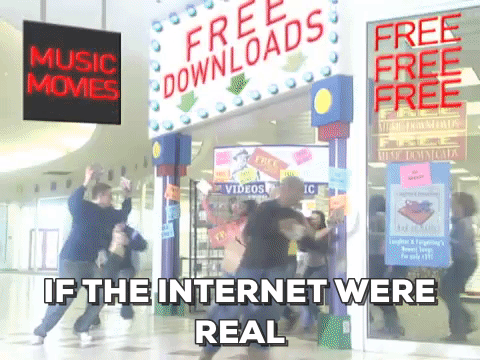One of my favorite Chappelle’s Show skits is when he imagines what it would be like if the internet were a real place. In the first part, he strolls into a mall and asks a kid if he knows where he can get any music. It goes something like this:
Dave Chappelle: Hey do you know where I can get some music?
Kid, pointing to a $.99 music store: Sure! You can go right there …
Dave Chappelle: Ok…
Kid, pointing to FREE DOWNLOADS store: …or you can go there…

The next scene shows Chappelle walking down the hallway with a huge , overflowing bag that says “Free Downloads” on it.
After receiving a particularly terrible set of repetitive, useless emails from a SaaS provider (that I actually really like) the other day, I spent some time trying to figure out why bad emails from services I use bother me so much. I tried to think of a good metaphor to explain it, and then the Chappelle show “real life Internet” skit popped into my head. I started to imagine what it would be like if restaurants treated patrons the way that many SaaS providers treat their customers…and then I started to get even more annoyed about how badly some companies flub a crucial opportunity to build trust with their customers by sending terrible emails.
Looking for a place to eat
You’re walking down the street and every single restaurant has employees standing out front, trying to hand you flyers, telling you how much you’ll enjoy the experience of eating there.
But not only do they harass you once, they follow you. They wait 10 steps to yell out to you again, then another 25 steps, and then another 50. Eventually they’re screaming and running around in circles as you walk further and further away, never to return.
Walking in the front door
After you get to the restaurant you were looking for, you walk in the front door and the first person you encounter starts lecturing you about how well built the structure of the restaurant is. They’re telling you about steel girders and maximum amperage. They want to remind you that all of the people who work at the restaurant are actually people, so they start showing you employees pictures.
You try to ask for a menu but for some reason the person you met when you walked in is still droning on about how the walls will never crumble and how they can handle up to 1,500 meals per day (MPD). You finally find the menu and order something.
Waiting for your food
As soon as your order is placed, a completely different server comes to your table and asks you if you’re sure you wouldn’t like to order something larger? How about some wine? It’s 11AM? How about some wine?
The architecture lecture seems to finally be over. You’ve ordered your food. You were firm about no upsells, no wine, you just want your food and that’s it. You eat some of the bread on the table, drink some water, and wait.
Suddenly, your server returns, asking you how your meal was and asking why you haven’t ordered dessert yet. Confusedly you reply that you’re still waiting for your food. The server just stands there staring at you.
Finally, the meal
After winning several staring contests with your server, someone else comes and delivers your food. You’re actually pretty excited about eating here, your friends told you it was great, and it’s just the kind of food you were in the mood for.
You take a few bites and — surprise! Your server is back asking you if you wouldn’t mind filling out a form with 5 questions about how much you love the restaurant and asking if you would recommend it to a colleague.
You suffer through some more upsells, get even more confused, and finally leave.
We can do better
The frustrating thing about the abundance of shitty email is that achieving great email communication with your users, both trials and actual customers, isn’t that hard, if you actually want to do it.
After trying to boil down my thoughts on the subject, I realized that one framework for doing well with email is to do it in the most humane way possible. If you spend time actually thinking about what the experience of getting emails as a customer will be like, you will do a lot better if you’re honest with yourself.
Here are a few guidelines you can follow to not screw up your customer-facing emails:
-
Don’t send too many emails. Seriously.
-
Don’t do behavioral emails if you don’t have the energy and time to do them properly.
-
Don’t automate too early.
-
Make sure that every email you send offers substantial value to the person you’re sending it to.
-
Remember: you’re sending these emails to ACTUAL PEOPLE.
If we can make great software that delivers value and solves real problems, we can definitely afford to take the time to get the communication right. Trust me, it’s worth it.
